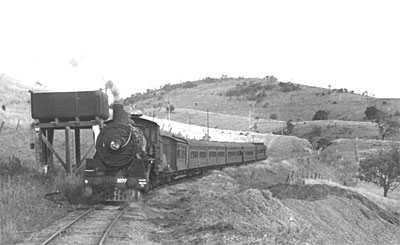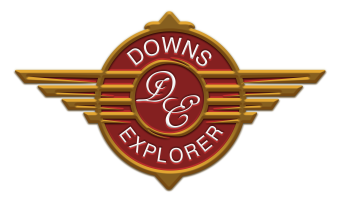The Sydney Mail for over 40 years was Queensland’s crack train, and it deserves a study on its own.

Sydney Mail hauled by BB18 1/4 1077, passes the Gorge Tank.
With the opening of both gauges to the border, it began running with the following timetable:
| Southbound |
|
|
Northbound |
|
|
| Stations |
|
Time |
Stations |
|
Time |
| Brisbane |
dep |
7.00 p.m. |
Sydney |
dep |
5.20 p.m. |
| Toowoomba |
a/d |
12.25-35 a.m. |
Wallan-garra |
a/d |
4.30-5 p.m.
(next day) |
| Warwick |
a/d |
4.00-10 a.m. |
Stanthorpe |
a/d |
6.20 p.m. |
| Stanthorpe |
a/d |
6.20-25 a.m. |
Warwick |
a/d |
8.40-9.15 p.m. |
| Wallan-garra |
a/d |
7.45-8.15 a.m. |
Toowoomba |
a/d |
12.35-50 a.m. |
| Sydney |
arr |
6.48 am
(next day) |
Brisbane |
arr |
6.15 a.m. |
About 1894, with ship travel still more popular, the timetable was improved to one which has operated without substantial change ever since. After the introduction of the C-16 class engine, the timetable was modified slightly as the 1907 schedule indicates:
| Southbound |
|
|
Northbound |
|
|
| Stations |
|
Time |
Stations |
|
Time |
| Brisbane |
dep |
7.10 a.m. |
Sydney |
dep |
5.10p.m. |
| Toowoomba |
a/d |
11.55-12.15 p.m. |
Wallan-garra |
a/d |
11.00-35a.m. (next day) |
| Warwick |
a/d |
2.47-54 p.m. |
Stanthorpe |
a/d |
12.34p.m. |
| Stanthorpe |
a/d |
4.40 p.m. |
Warwick |
a/d |
2.09-4 p.m. |
| Wallan-garra |
a/d |
5.45-6.10 p.m. |
Toowoomba |
a/d |
4.46-5.06 p.m. |
| Sydney |
arr |
11.10 am (next day) |
Brisbane |
arr |
9.25 p.m. |
Stanthorpe a/d 4.40 p.m. Warwick a/d 2.09-16p.m. Wallan-garra a/d 5.45-6.10 p.m. Toowoomba a/d 4.46-5.06p.m. Sydney arr 11.10 am (next day) Brisbane arr 9.25 p.m.
The Queensland journey had been accelerated by two hours on the up and three on the down, with only 8 stops between Wallan-garra and Toowoomba on the down trip. A further acceleration occurred when the first B17 class engines arrived in 1911. Then in 1915, the C18 class including the two named engines Sir William and Lady MacGregor took over. These were built specially for the Sydney Mail with the object of eliminating the need for PB15 class assistance over the Little Liverpool and Main Ranges and to Dalveen.
New sets of carriages were built and entered service in 1923 to form the two Sydney Mail sets were: AL 1036, AL 1037, BL 1040, BL 1041, BL 1042, CL 1046 and PARL 1048 entered service in November, and AL 1038, AL 1039, BL 1043, BL 1044 BL 1045, CL 1047 and PARL 1049 entered service in December. (BL 1040 is now owned by SDSR)
(AL = First Class, BL = Second Class, CL = Both First and Second Class, and PARL = Parlour Car).
The timetable in 1924 was:
| Southbound |
|
|
Northbound |
|
|
| Stations |
|
Time |
Stations |
|
Time |
| Brisbane |
dep |
8.05 p.m. |
Sydney |
dep |
2 p.m. & 3.30 p.m. |
| Toowoomba |
a/d |
12.10-30 p.m. |
Wallan-garra |
a/d |
8.40 & 9.07-9.30am |
| Warwick |
a/d |
2.54-3.04 p.m. |
Stanthorpe |
a/d |
10.27 a.m. |
| Stanthorpe |
a/d |
4.55 p.m. |
Warwick |
a/d |
11.55-12.03 p.m. |
| Wallan-garra |
a/d |
5.55-6.17 & 6.40pm |
Toowoomba |
a/d |
2.20-2.40 p.m. |
| Sydney |
arr |
11.25 a.m. & 1.10 p.m. |
Brisbane |
arr |
6.40 p.m. |
The first Pacific B18 class engine No.84 made a successful trial run to Toowoomba on the Sydney Mail on 28th July, 1926.
After the opening of the New South Wales North Coast line to South Brisbane via Kyogle, the Limited Express on the New South Wales side of the border was withdrawn and the Queensland ‘sweeper’ service cut back to Warwick to below the range. There was still some overcrowding as railwaymen on passes were not allowed on the Kyogle route for some time.
In 1945, the timetable read:
| Southbound |
|
|
Northbound |
|
|
| Stations |
|
Time |
Stations |
|
Time |
| Brisbane |
dep |
7.45 p.m. |
Sydney |
dep |
1.15p.m. |
| Toowoomba |
a/d |
12.05-30 p.m. |
Wallan-garra |
a/d |
8.27-55 a.m. (next day) |
| Warwick |
a/d |
3.01-2 p.m. |
Stanthorpe |
a/d |
10.06 a.m. |
| Stanthorpe |
a/d |
5.07-12 p.m. |
Warwick |
a/d |
11.58-12.10 p.m. |
| Wallan-garra |
a/d |
6.22-7.02 p.m. |
Toowoomba |
a/d |
2.34-3.00 p.m. |
| Sydney |
arr |
1.25 p.m. (next day) |
Brisbane |
arr |
7.05 p.m. |
The service postwar was reduced to four, then three per week and even two during a New South Wales Railways’ economy drive between 1957 and 1960. Little further change in timetable occurred until ‘dieselisation’, the times now being:
| Southbound |
|
|
Northbound |
|
|
| Stations |
|
Time |
Stations |
|
Time |
| Brisbane |
dep |
8.15 a.m. |
Sydney |
dep |
3.10 p.m. |
| Toowoomba |
a/d |
12.03-28 p.m. |
Wallan-garra |
a/d |
7.23-55 a.m. (Tu, Th, Sa) |
| Warwick |
a/d |
2.30-40 p.m. |
Stanthorpe |
a/d |
8.59 a.m. |
| Stanthorpe |
a/d |
4.25 p.m. |
Warwick |
a/d |
10.45-54 a.m. |
| Wallan-garra |
a/d |
5.30-6.15 p.m. |
Toowoomba |
a/d |
12.47-1.26 p.m. |
| Sydney |
arr |
9.59 a.m. (We, Fr, Su) |
Brisbane |
arr |
5.15 p.m. |
There were frequent disagreements between the two Administrations as the trains were more important to Queensland than to New South Wales, which however had to run twice as far and so services have always been adjusted to fit in with the Southern State. Thus, running three times weekly, the Queensland Railways had to use two sets of coaches to run less than half the mileage that New South Wales was able to run with one. It was a long struggle to get agreement for trains to leave each capital on Saturdays, although when introduced in 1905, it was quite popular.
Until 1930, the service saw the best of Queensland’s rolling stock including parlour cars with revolving chairs and all the latest known features when built in 1910.
Another new train was built in Ipswich to replace one burnt out at Wallan-garra in January, 1913 – perhaps the most serious carriage fire in the state. Small buffets for light refreshments were included, manned by the conductors, but these facilities were withdrawn in 1930. Station staff along the line were asked to water platforms to avoid dust nuisance to passengers. Apart from the parlour cars, these distinctive Sydney Mail trains ran to Wallan-garra for over 60 years, and they were a delight to the passenger wishing to view the mountain scenery in fresh air.

